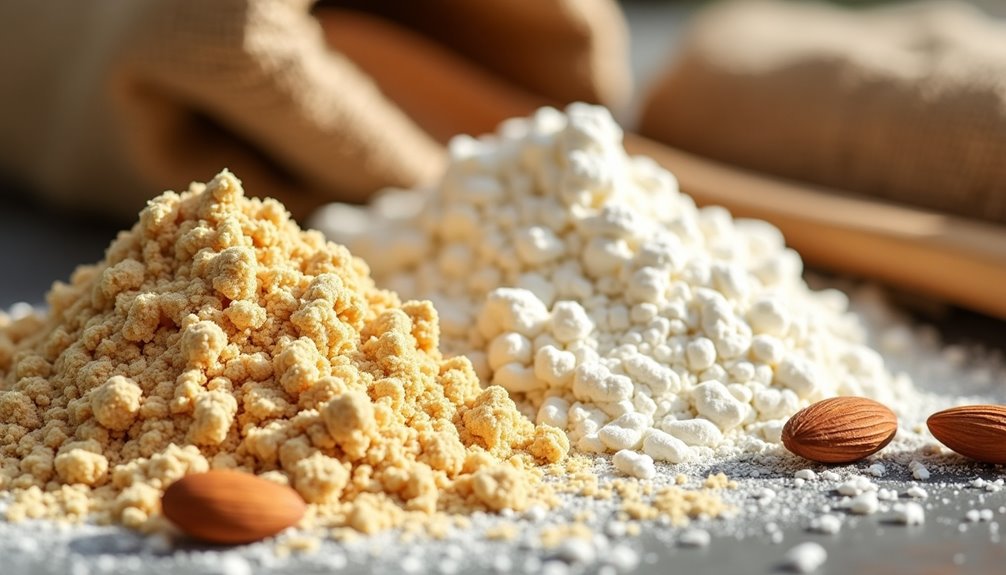Almond flour is an excellent alternative to regular flour, especially for gluten-free recipes. When substituting, use about 1 cup of almond flour for every 1/4 to 1/3 cup of regular flour, as almond flour absorbs moisture differently. You'll often need additional binding agents like eggs to maintain structure in your baked goods, which can result in a denser, moister texture. Besides its delicious nutty flavor, almond flour enhances your dish's nutritional value, offering high protein and healthy fats. If you're curious about specific recipes and further adjustments, there's plenty more to explore on this topic.
Key Takeaways
- Substitute almond flour for regular flour at a ratio of 1 cup almond flour to 1/4 to 1/3 cup regular flour.
- Almond flour has a denser, moister texture, affecting the final product's structure and crumb.
- Adjust recipes by adding extra binding agents like eggs to enhance the structure and moisture retention.
- Monitor baking times and temperatures as almond flour retains moisture, leading to different baking results.
- Store almond flour in an airtight container, refrigerating for longer shelf life and ensuring freshness.
What Is Almond Flour?

Almond flour, made from finely ground almonds, serves as a popular alternative to traditional wheat flour, particularly in gluten-free and low-carb diets. Understanding what almond flour is can enhance your baking and cooking experience.
Almond flour is typically available in two primary varieties: blanched and unblanched. Blanched almond flour is made from almonds that have had their skins removed, resulting in a finer texture and lighter color. It's ideal for recipes that require a smooth consistency, such as cakes and cookies.
Conversely, unblanched almond flour retains the skin, offering a coarser texture and a slightly nuttier flavor, which can add depth to breads and muffins.
The texture of almond flour significantly influences your culinary results. When you incorporate almond flour, you'll notice that it absorbs moisture differently than wheat flour. This characteristic can lead to denser baked goods unless you adjust your recipe accordingly. For instance, you might need to add extra eggs or other binding agents to achieve the desired structure.
You'll also find that almond flour behaves differently in various recipes, so experimenting with textures can yield delightful surprises. Whether you're aiming for a light and airy cake or a hearty bread, choosing the right almond flour variety can make all the difference. By exploring the nuances of almond flour, you can create dishes that not only meet dietary needs but also offer a sense of belonging to the growing community of health-conscious cooks.
Nutritional Benefits of Almond Flour
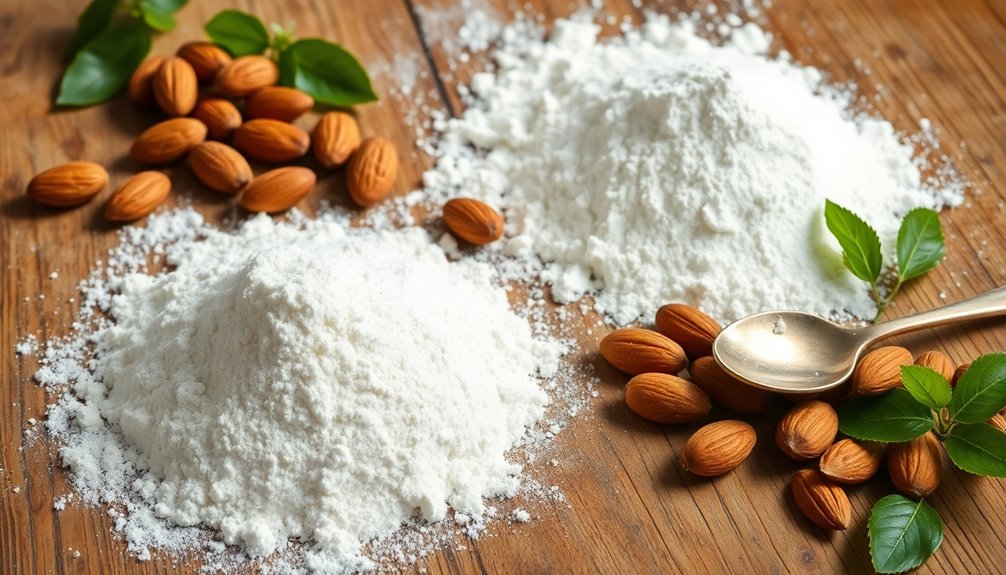
Packed with nutrients, almond flour offers a range of health benefits that make it a valuable addition to your diet. One of the standout features of almond flour is its rich nutritional profile.
It's high in protein, boasting around 6 grams per ounce, which can help you feel fuller for longer. This makes it an excellent choice for those looking to manage their weight or maintain energy levels throughout the day.
Additionally, almond flour is a great source of healthy fats, particularly monounsaturated fats. These fats can support heart health and may contribute to lower cholesterol levels.
You'll also find that almond flour is packed with vitamins and minerals, including vitamin E, magnesium, and calcium, all of which play significant roles in your overall health.
When it comes to culinary uses, almond flour shines in various recipes. It can be used in baked goods, like muffins and pancakes, offering a unique flavor and moist texture. Plus, it's gluten-free, making it an ideal alternative for those with gluten sensitivities or celiac disease.
Incorporating almond flour into your meals not only enhances the taste but also boosts the nutritional value.
How to Substitute Almond Flour

Incorporating almond flour into your recipes can enhance both flavor and nutrition, but understanding how to substitute it effectively is vital to achieving the desired results in your dishes. When swapping almond flour for regular flour, you need to pay attention to almond flour ratios. Typically, you can use 1 cup of almond flour for every 1/4 to 1/3 cup of regular flour. This is because almond flour is denser and more moisture-retentive.
Here's a quick reference table to help you with almond flour ratios:
| Ingredient | Amount for Almond Flour |
|---|---|
| All-Purpose Flour | 1/4 – 1/3 cup |
| Whole Wheat Flour | 1/4 – 1/3 cup |
| Coconut Flour | 1/2 – 1 cup |
| Gluten-Free Blend | 1/3 – 1/2 cup |
When using almond flour, remember to adjust your baking techniques. Since almond flour doesn't contain gluten, you might want to use additional binding agents like eggs or flaxseed meal to help maintain structure. This can be especially important in recipes like cookies or cakes, where texture is essential.
Baking With Almond Flour
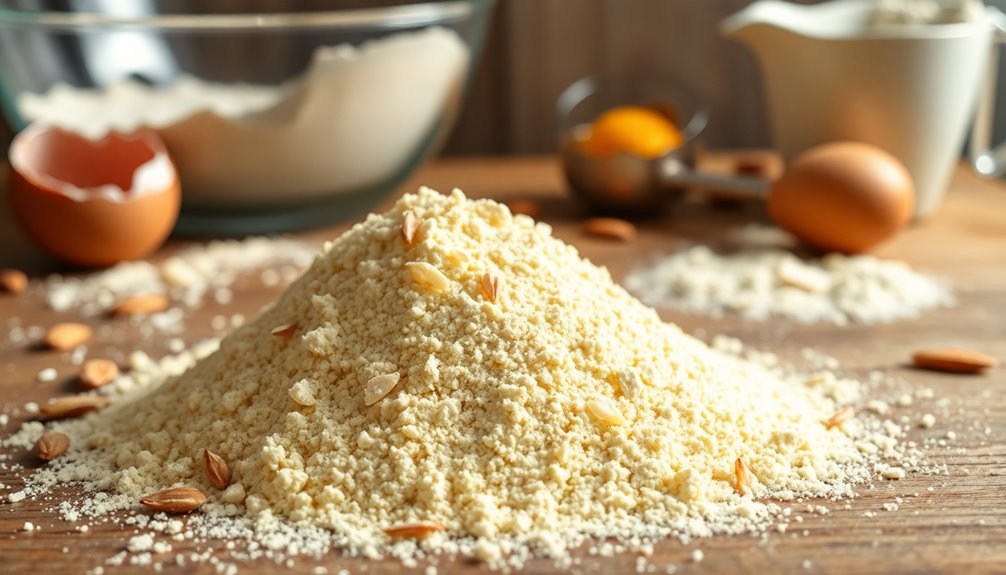
When baking with almond flour, you'll notice significant differences in texture and moisture compared to traditional flours. Almond flour, made from finely ground almonds, brings a unique richness and moisture to your baked goods. This can lead to a denser texture, which some people may find delightful, while others might prefer the lighter crumb of wheat flour.
The texture variances are particularly evident in recipes for cakes, muffins, and cookies. You might find that almond flour yields a slightly more crumbly product, which can enhance the mouthfeel in certain treats. To balance this, you may want to experiment by combining almond flour with other gluten-free flours to achieve the desired consistency.
In terms of flavor profiles, almond flour introduces a subtle nuttiness that can elevate your recipes. This added depth works beautifully in baked goods, especially in recipes like brownies or pancakes, where the nutty flavor complements the sweetness. However, it's crucial to consider how this flavor interacts with other ingredients. For instance, when baking with chocolate, the almond flavor can enhance the overall experience.
When making the switch to almond flour, pay close attention to baking times and temperatures. Since it retains more moisture, your baked goods may require slight adjustments to make sure they cook evenly. Embracing these differences can lead to a gratifying baking experience, allowing you to create delicious, health-conscious treats that everyone will enjoy.
Cooking Tips for Almond Flour
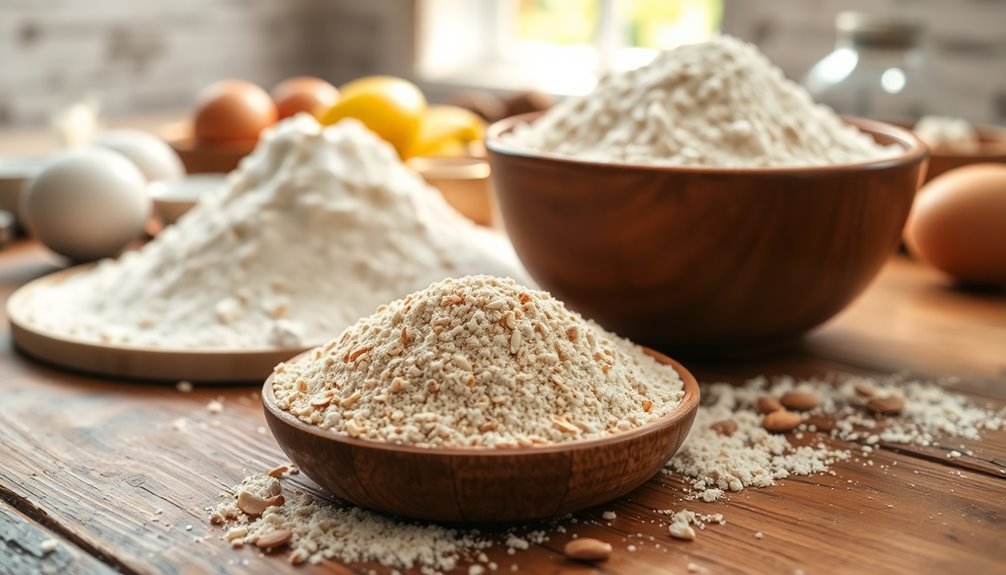
Mastering the art of cooking with almond flour can transform your culinary creations, offering both health benefits and unique flavor profiles. To effectively incorporate almond flour into your recipes, you'll need to adjust your baking techniques. Since almond flour lacks gluten, it's crucial to combine it with binding agents like eggs or flaxseed meal to achieve the desired structure in baked goods. You might also consider mixing almond flour with other gluten-free flours for a balanced texture and flavor.
When it comes to flavor pairings, almond flour shines when combined with ingredients that complement its nutty essence. Think about incorporating spices like cinnamon or nutmeg in sweet recipes, or pairing it with savory elements like rosemary and garlic for bread. These combinations can elevate your dishes and create a well-rounded taste experience.
Keep in mind that almond flour absorbs moisture differently compared to regular flour, so you may need to adjust your liquid ingredients accordingly. Start with a smaller amount and gradually increase it until you achieve the right consistency.
Additionally, be cautious with baking times; almond flour tends to brown faster, so monitor your creations closely to prevent over-baking.
Lastly, don't hesitate to experiment. Cooking with almond flour opens up a world of culinary possibilities, allowing you to create dishes that are both nutritious and delicious. By embracing these tips, you'll not only enhance your cooking skills but also foster a deeper connection with the food you prepare.
Recipes Using Almond Flour
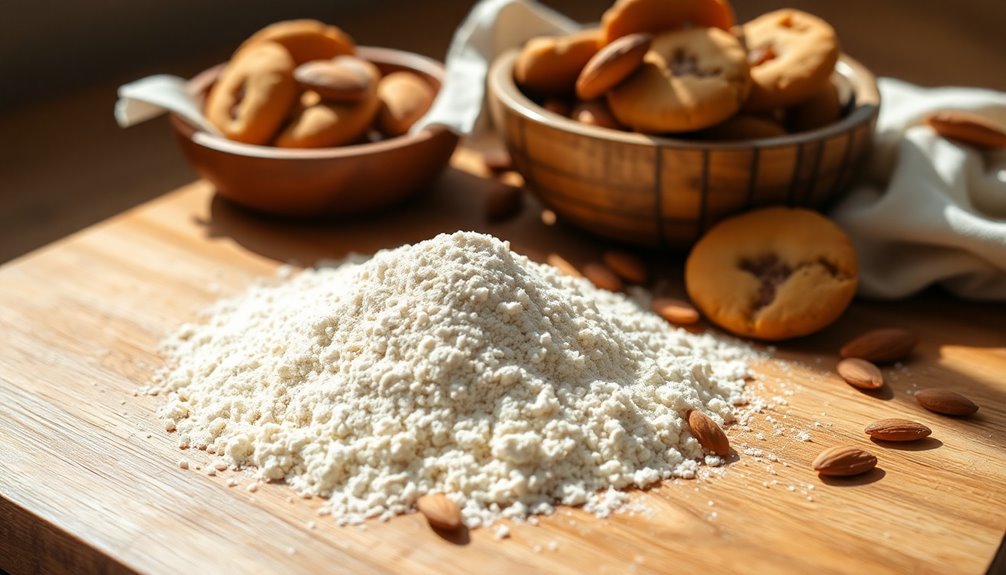
Exploring recipes that utilize almond flour can open up a new world of culinary creativity, allowing you to enjoy both delicious flavors and health benefits. One of the simplest yet satisfying dishes you can make is almond flour pancakes. They're not just gluten-free; they also provide a nutty flavor and a fluffy texture. To whip up a batch, combine almond flour, eggs, milk (or a dairy-free alternative), and a pinch of baking powder. Cook them on a hot griddle for a few minutes on each side, and you've got a breakfast treat that's both nutritious and indulgent.
Another delightful option is almond flour cookies. These treats are perfect for satisfying your sweet tooth while keeping your diet in check. By substituting regular flour with almond flour, you'll create cookies that are rich in flavor and moist. Mix almond flour with coconut sugar, vanilla extract, and eggs, then add your favorite mix-ins, like dark chocolate chips or nuts. Bake until golden brown, and you'll have a batch of cookies that everyone will love.
Incorporating almond flour into your recipes not only enhances their taste but also boosts their nutritional profile. Whether you're flipping pancakes or baking cookies, you're making a choice that aligns with a healthier lifestyle. With these recipes, you can enjoy the benefits of almond flour while feeling connected to a community that values culinary exploration and well-being.
Common Mistakes to Avoid
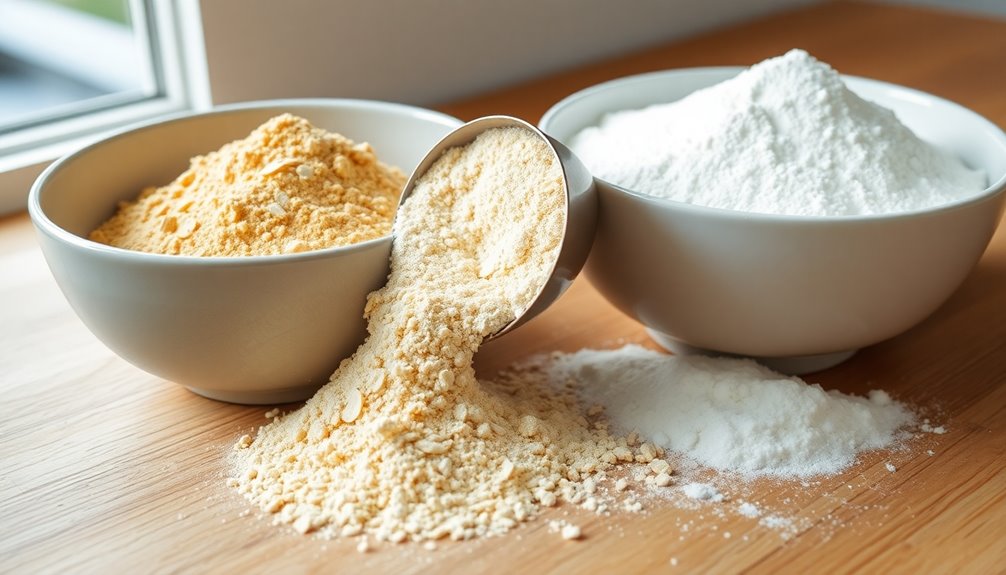
Many home cooks make critical mistakes when substituting almond flour for regular flour, which can greatly impact the outcome of your dishes. One common error is using the same ingredient ratios. Almond flour is denser and absorbs moisture differently, so you need to adjust your baking techniques accordingly.
Here's a quick reference table to help you avoid common pitfalls:
| Mistake | Consequence | Solution |
|---|---|---|
| Using a 1:1 ratio | Dry and crumbly texture | Use 1 cup almond flour for every 1.5 cups regular flour |
| Skipping eggs in recipes | Lack of structure | Add an extra egg or egg substitute |
| Not adjusting baking time | Overbaked or underbaked goods | Monitor closely; check 5-10 minutes earlier |
| Ignoring additional moisture | Dry batter | Add extra liquid or fat to recipes |
| Using almond flour alone | Unbalanced flavors | Combine with other gluten-free flours |
Avoiding these errors will enhance your baking experience. Remember, mastering almond flour requires patience and practice. By understanding the unique properties of almond flour and adjusting ingredient ratios, you'll create delicious, satisfying dishes that everyone can enjoy. Don't hesitate to experiment and fine-tune your recipes; after all, that's where the joy of baking lies!
Almond Flour vs. Other Alternatives
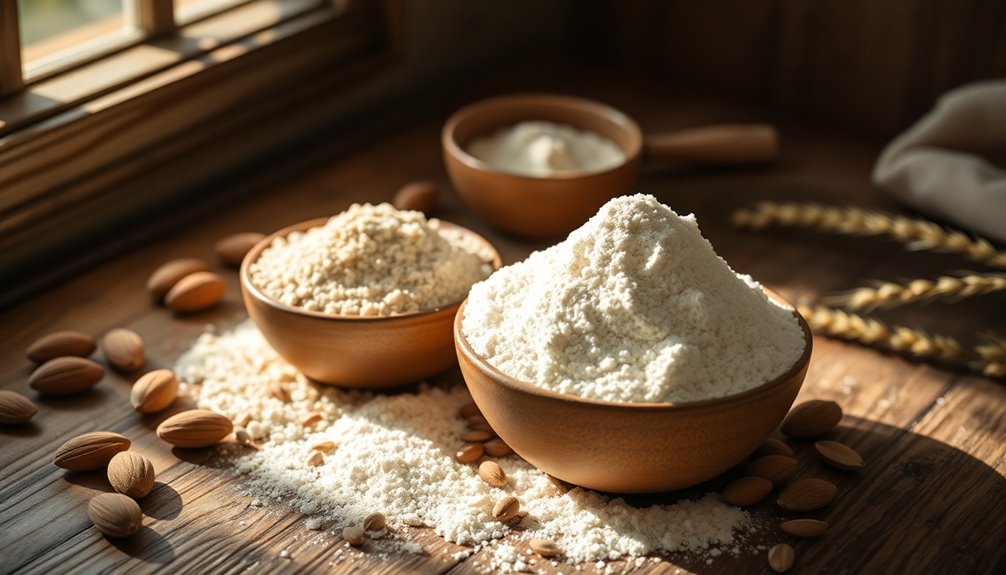
While understanding how to effectively use almond flour is essential, it's also important to compare it with other gluten-free alternatives available. Almond flour stands out for its nutty flavor and moist texture, but how does it stack up against options like coconut flour, oat flour, and gluten-free blends?
When it comes to baking techniques, almond flour typically requires adjustments in recipes. For instance, its higher fat content may lead to denser baked goods, while other alternatives like coconut flour absorb more moisture, necessitating additional liquids. If you're switching between these flours, be prepared to experiment with ratios and ingredient combinations to achieve the desired consistency.
In terms of flavor comparison, almond flour offers a distinct nutty taste that can enhance sweet treats, but it mightn't suit every palate. Coconut flour provides a subtle sweetness, which might be perfect for tropical-inspired desserts. Oat flour, on the other hand, has a mild flavor that works well in savory dishes, making it a versatile choice for those who prefer neutral tastes.
Ultimately, the best alternative often depends on your specific recipe and personal preferences. If you enjoy the taste and texture that almond flour brings, it can be an excellent choice. However, don't hesitate to explore other alternatives to find what works best for your baking endeavors. Embracing these options can lead to a more inclusive and satisfying baking experience for you and your loved ones.
Storage Tips for Almond Flour

To maintain the quality and freshness of almond flour, proper storage is essential. Almond flour is sensitive to moisture and heat, so using a proper container is key. Ideally, you should store your almond flour in an airtight container that prevents air and moisture from getting in. Glass jars or high-quality plastic containers work well for this purpose.
You may also consider the refrigeration option for long-term storage. Keeping almond flour in the refrigerator can help extend its shelf life, especially if you buy in bulk. Just make sure to let it come to room temperature before using it in your recipes to avoid clumping.
Here's a quick overview of storage options:
| Storage Method | Container Type | Shelf Life |
|---|---|---|
| Room Temperature | Airtight Glass/Plastic | 1-2 months |
| Refrigeration | Airtight Glass/Plastic | 4-6 months |
| Freezing | Freezer-Safe Container | 6-12 months |
| Check for Freshness | Smell and Visual Check | Use as needed |
Frequently Asked Questions
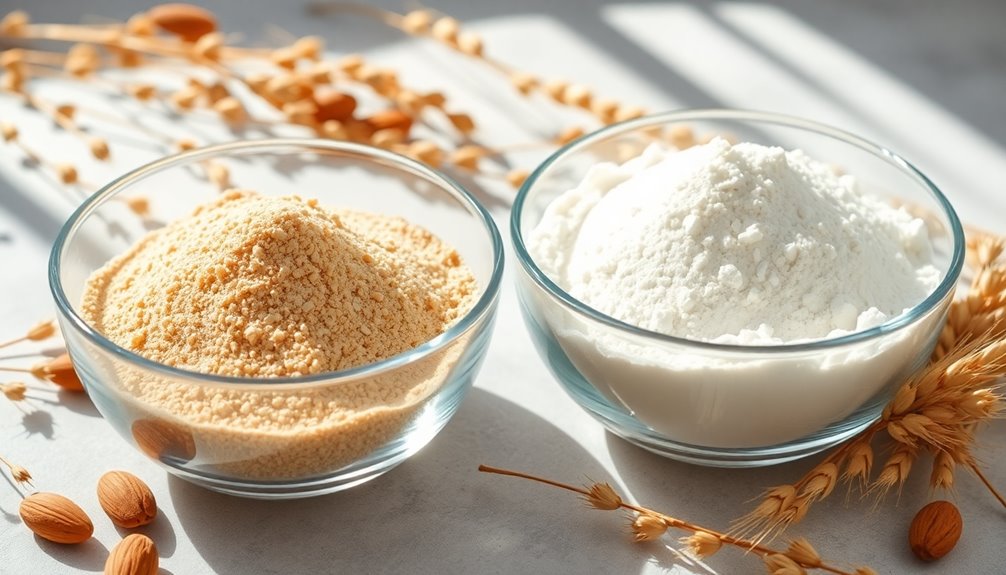
When it comes to using almond flour as a substitute for regular flour, you likely have some questions about its properties and best practices.
First, let's talk about almond flour texture. Unlike regular flour, almond flour has a coarser grain, which can affect the final outcome of your baked goods. If you're aiming for a denser product, this texture can work in your favor. However, if you prefer a lighter, fluffier texture, consider sifting the almond flour or blending it to achieve a finer consistency.
Now, let's address almond flour taste. Almond flour has a mild, nutty flavor that can enhance many recipes. Keep in mind that this taste may not work in every dish. For instance, in sweet baked goods, it can complement flavors like chocolate or vanilla beautifully. On the other hand, in savory recipes, the nutty flavor may stand out more than you'd like, so it's essential to balance it with other ingredients.
Another common question is about substitution ratios. Generally, you can substitute almond flour for regular flour at a 1:1 ratio, but you may need to adjust the liquid in your recipe, as almond flour absorbs moisture differently.
Frequently Asked Questions
Is Almond Flour Gluten-Free for Those With Celiac Disease?
Yes, almond flour is gluten-free, making it a safe choice for you if you have celiac disease. It offers nutritional value, packed with protein and healthy fats, which can enhance your diet. When you explore baking alternatives, almond flour can create a delightful texture in your recipes. Just make sure you're using certified gluten-free almond flour to avoid cross-contamination.
Enjoy experimenting with this versatile ingredient in your gluten-free baking adventures!
Can Almond Flour Be Used in Savory Dishes?
Absolutely, you can use almond flour in savory dishes! Imagine a world where flavor combinations explode like fireworks, and every bite has a delightful crunch! Almond flour brings unique texture variations that elevate your meals.
It's perfect for breading proteins or thickening sauces. You'll discover a new depth in your recipes, creating a sense of belonging around the dinner table as everyone savors the unexpected taste.
What Is the Shelf Life of Almond Flour?
The shelf life of almond flour usually lasts six months to a year when stored correctly. For best freshness, keep it in an airtight container in a cool, dark place. You can also refrigerate or freeze it for extended storage. When you're using it in baking recipes, always check for any off smells or discoloration. Following these storage tips guarantees you receive the highest quality and flavor in your dishes.
Does Almond Flour Affect Blood Sugar Levels?
When Jane switched to almond flour for her baking, she noticed improved blood sugar control. Unlike traditional flours, almond flour's low glycemic index helps stabilize blood sugar levels. Its high fiber and healthy fat content provide additional nutritional benefits, which can aid in satiety and overall health.
Can I Make Almond Flour at Home?
Yes, you can make almond flour at home easily! Just take blanched almonds and blend them until you achieve a fine flour texture. This process not only gives you a fresh product but also allows you to enjoy the nutritional benefits of almonds, like healthy fats and protein.
Plus, it's a great baking alternative for those looking to diversify their cooking options. You'll feel empowered creating your own ingredients in the kitchen!
Conclusion
Incorporating almond flour into your cooking can greatly enhance your dishes while providing health benefits. Did you know that almond flour contains 50% more protein than regular wheat flour? This makes it a great choice for those looking to boost their protein intake. However, it's crucial to understand how to substitute it properly and avoid common pitfalls. With the right techniques, almond flour can elevate your baking and cooking, offering a nutritious alternative to traditional flour.

